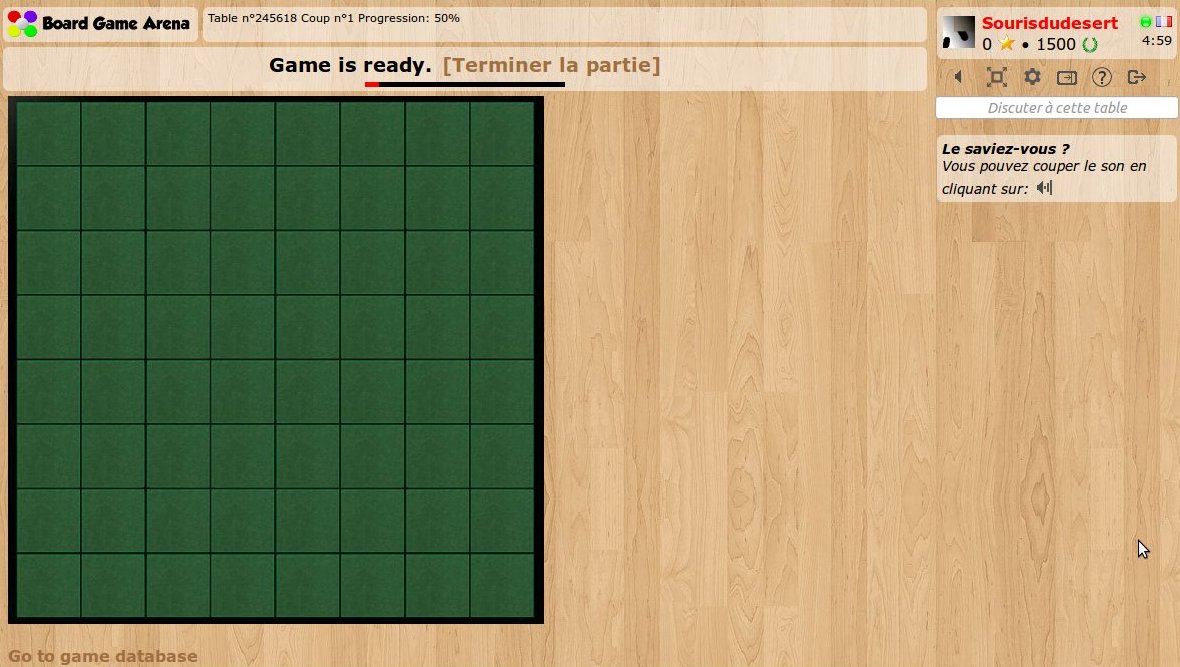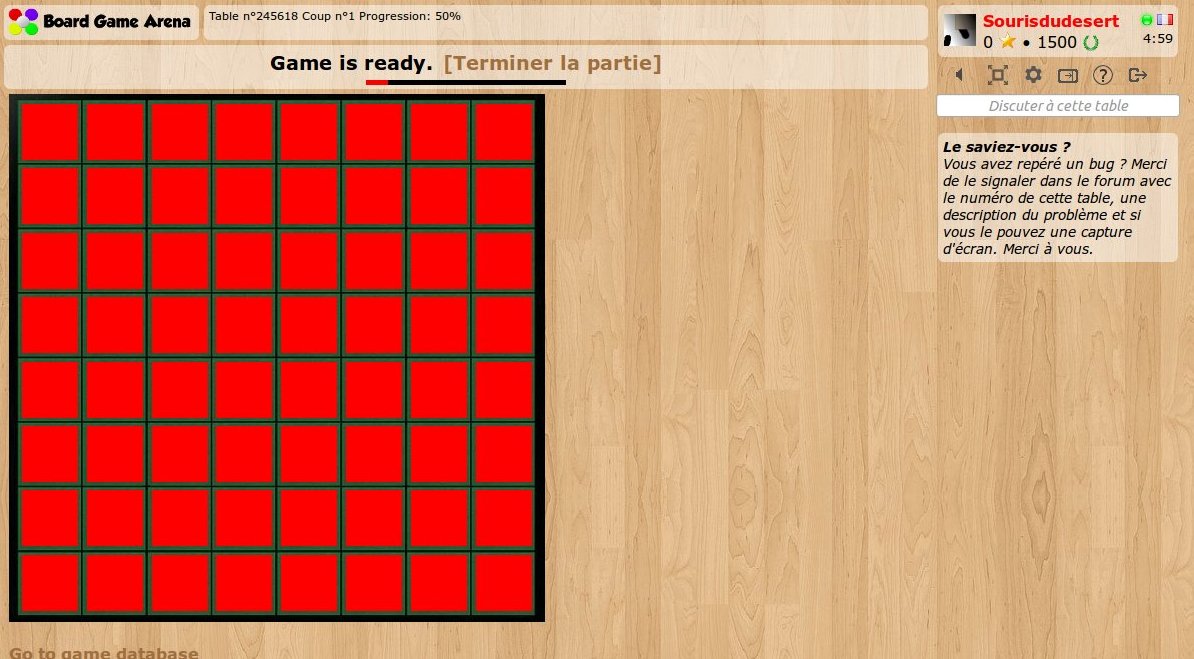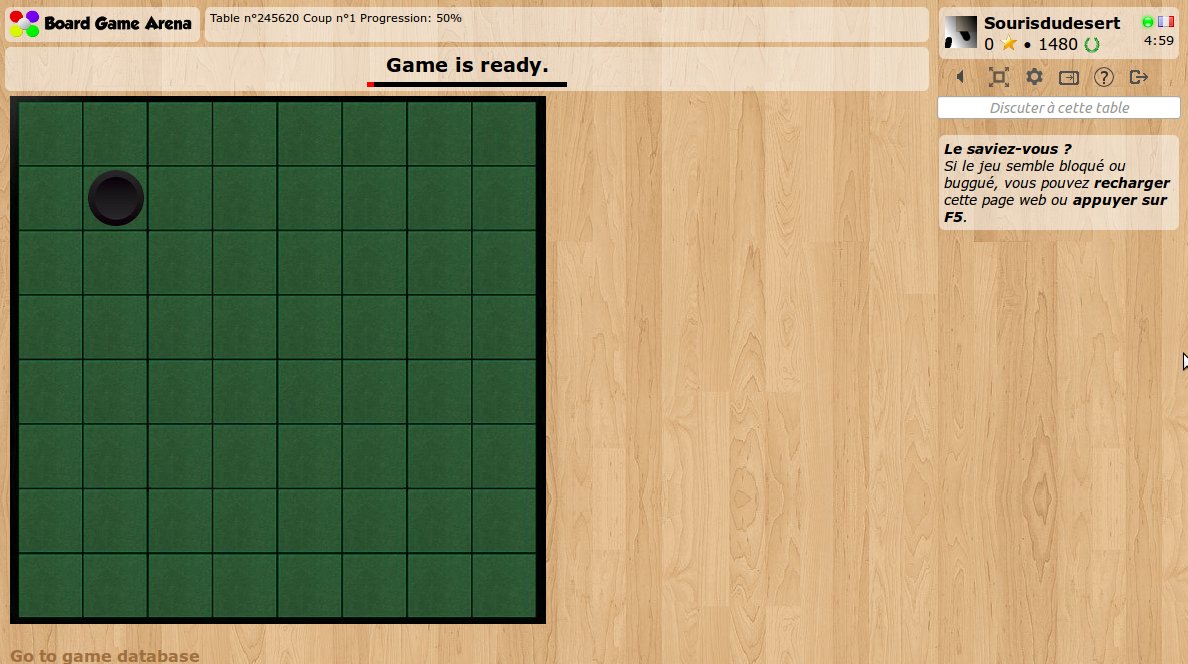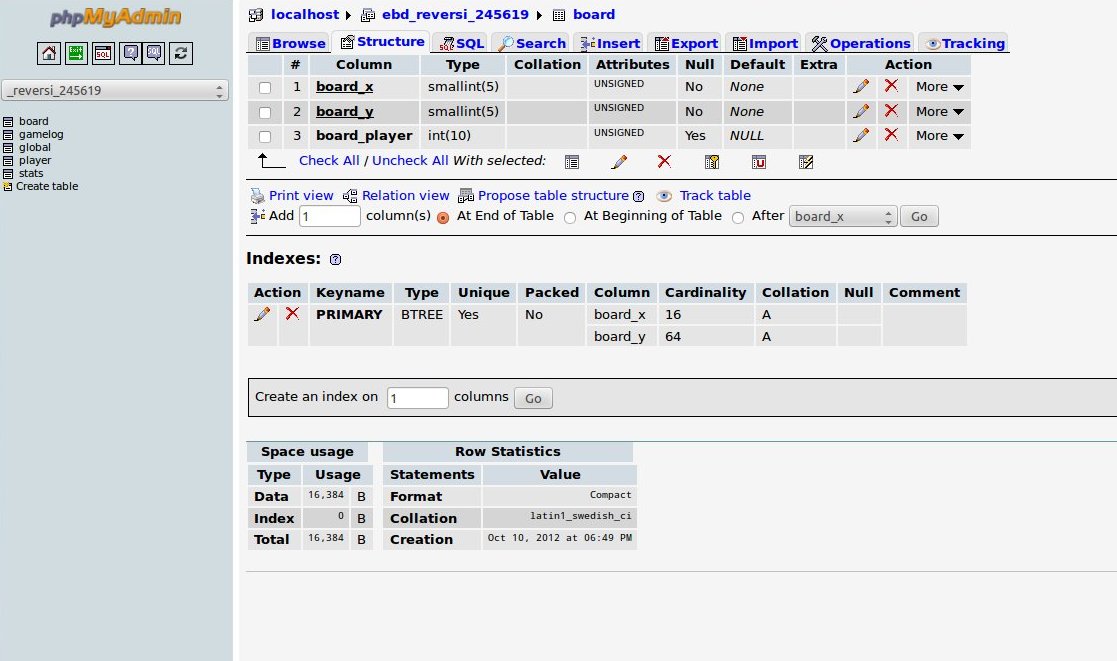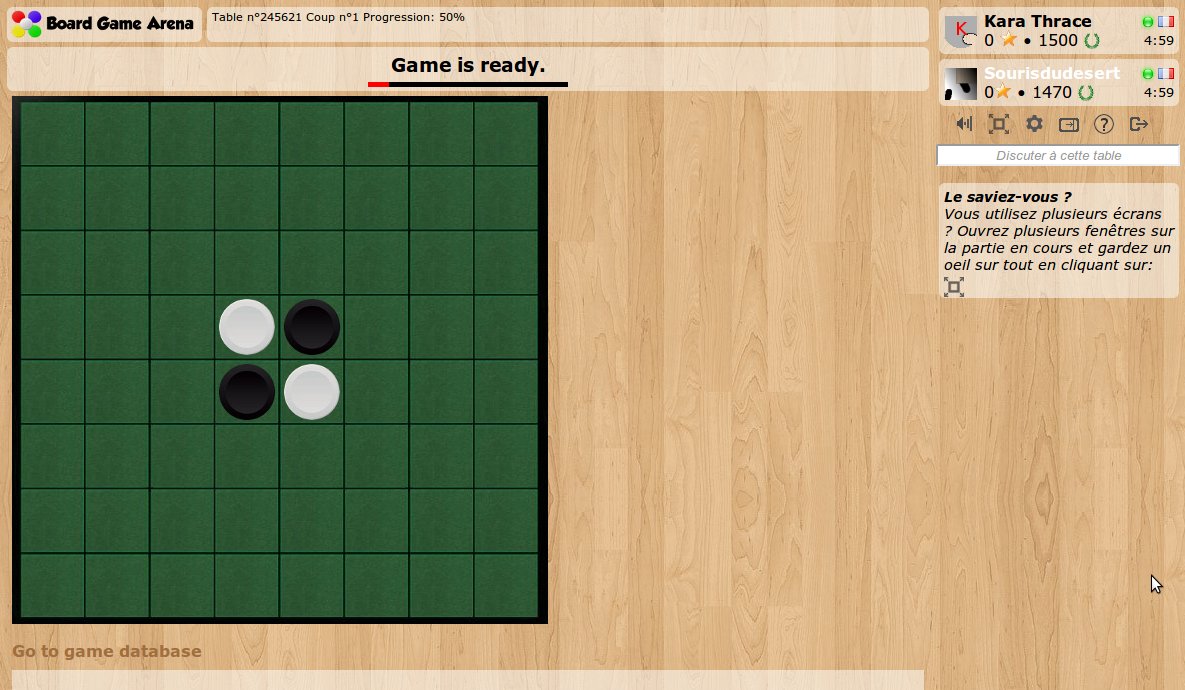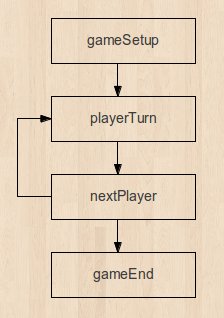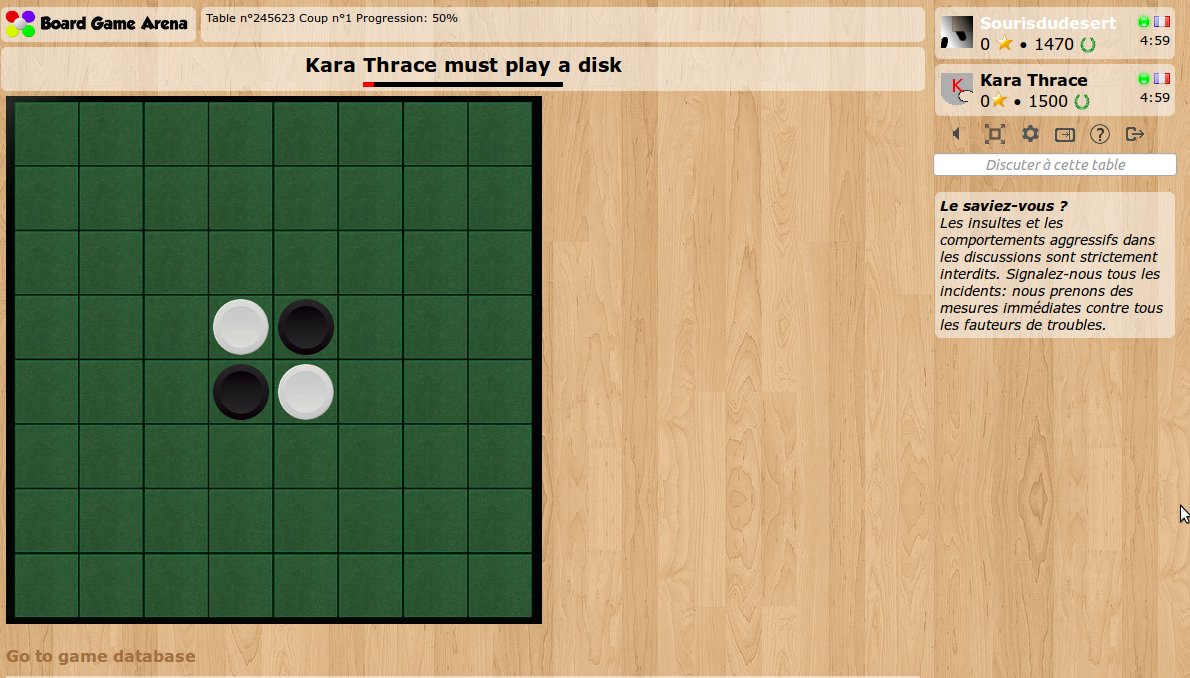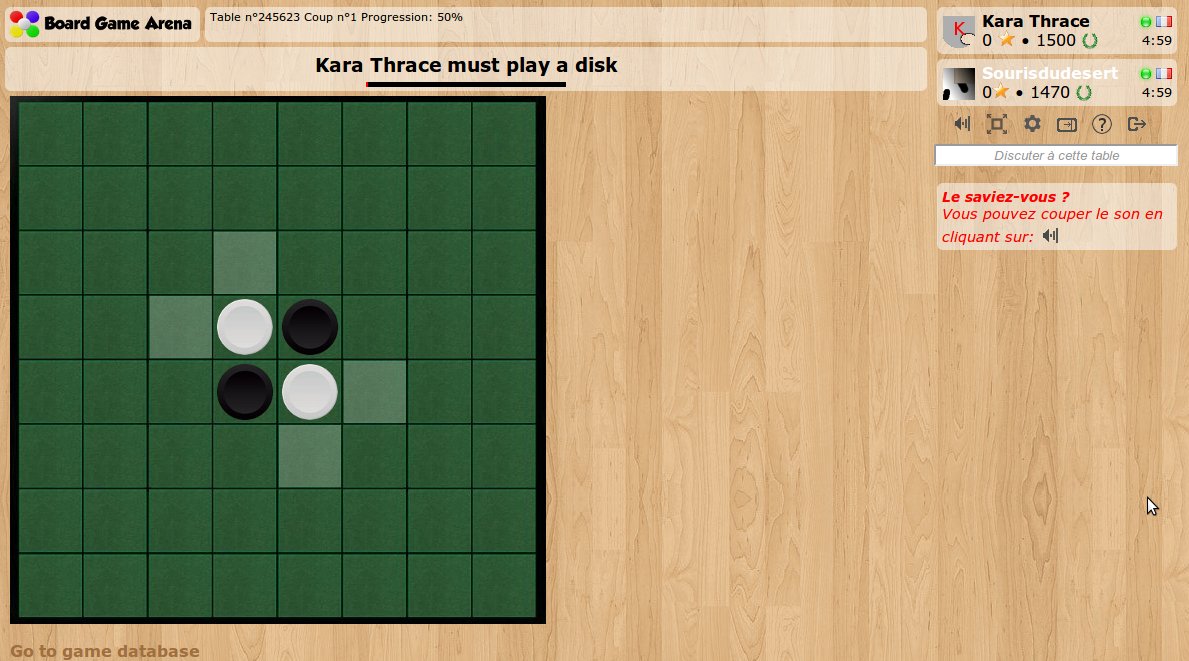This is a documentation for Board Game Arena: play board games online !
Tutorial reversi
Introduction
Using this tutorial, you can build a complete working game on the BGA environment: Reversi.
Before you read this tutorial, you must:
- Read the overall presentations of the BGA Framework (see here).
- Know the rules of Reversi.
- Know the languages used on BGA: PHP, SQL, HTML, CSS, Javascript
- Setup your development environment First Steps with BGA Studio
Create your first game
Note: you should already have created a project following instructions in Create a new game project. While you will find a reversi directory in your SFTP folder, do not use it for this tutorial. Instead, use the project you have created as an (empty) starting point.
With the initial skeleton of code provided in your project, you can already start a game from the BGA Studio:
- Go to your studio Control panel, then Manage games and select your initial project. Note: there are warnings displayed about a missing BGG_ID and presentation text. You can ignore that for now.
- Click the Play link next to your project name. This will open the Play page and offer to create a new table for your project. Optional: click the Heart icon to add your project to your favorite games list.
- On the Play page, on the top of the page, make sure that your settings are "Simple game", "Real time" and "Manual".
- Click "Create table" to create a table of your project.
- For now, we are going to work with one player only, so use the (-) button to set the number of players to 1. Most of the time it is simpler to proceed with only one player during the early phase of development of your game, as it's easy and fast to start/stop games. If you choose to start with 2 players, you should see two names on the right: testdude0 and testdude1. To switch between them, press the red arrow button near their names; it will open another tab. This way you don't need to login and logout from multiple accounts.)
- Reminder: Always use the "Express Start" button to start the game.
Thus, you can start a "Reversi" game, and arrive on a void, empty game. Yeah.
End the game by clicking on the game options icon on the top right, and then on "Express Stop".
(Optional) Editing the game information
This step is optional and will fix the warnings on the project page (missing BGG_ID and presentation).
- Edit your local copy of the gameinfo.inc.php file:
- Change the 'bgg_id' value from 0 to 2389 - that's around line 37.
- Add "1," to the players array - that's around line 41.
- Change the presentation array content - that's around line 134. Uncomment one line and change the text. Remove the final comma if you keep only one line!
- Upload the gameinfo.inc.php file to the SFTP server (see Connect to your SFTP folder).
- Go back to your project page, and in the "Game Information" section, click "Reload game information".
- Finally, refresh the project page in your browser (usually CTRL-F5).
Let it look like Reversi
It's always a good idea to start with a little bit of graphic work. Why? Because this helps to figure out how the final game will be, and issues that may appear later.
Be careful designing the layout of your game: you must always keep in mind that players with a 1024px screen width must be able to play. Usually, it means that the width of the play area can be 750px (in the worst case).
For Reversi, it's useless to have a 750x750px board - much too big, so we choose this one which fit perfectly (536x528):
Note that we are using a jpg file. Jpg are lighter than png, so faster to load. Later we are going to use PNGs for discs for transparency purpose.
Now, let's make it appear in our game:
- upload board.jpg in your "img/" directory. Warning: use lowercase file names!
- edit "reversi_reversi.tpl" to add a 'div' for your board.
Note: If you are building this game by following the tutorial, you will have a different project name than 'reversi'. The file names in your project will be different than shown in this tutorial, replacing 'reversi' with your project name. It should be trivial to find the right file in your project, but be sure that any code (other than comments) that references 'reversi' is changed to your actual project name.
<div id="board"> </div>
- edit your reversi.css file to transform it into a visible board:
#board {
width: 536px;
height: 528px;
background-image: url('img/board.jpg');
}
Important: refresh your page. Here's your board:
If the board does not appear, refresh the page (always do this when you update the CSS file), and check the image filename. Remember file names are case sensitive!
Make the squares appear
Now, we need to create some invisible HTML elements where squares are. These elements will be used as position references for white and black discs. We need 64 squares. To avoid writing 64 'div' elements on our template, we are going to use the "block" feature.
Let's modify our template like this:
<div id="board">
<!-- BEGIN square -->
<div id="square_{X}_{Y}" class="square" style="left: {LEFT}px; top: {TOP}px;"></div>
<!-- END square -->
</div>
As you can see, we created a "square" block, with 4 variable elements: X, Y, LEFT and TOP. We are going to use this block 64 times during page load.
Let's do it in our "reversi.view.php" file, inside the build_page function:
$this->page->begin_block( "reversi_reversi", "square" );
$hor_scale = 64.8;
$ver_scale = 64.4;
for( $x=1; $x<=8; $x++ )
{
for( $y=1; $y<=8; $y++ )
{
$this->page->insert_block( "square", array(
'X' => $x,
'Y' => $y,
'LEFT' => round( ($x-1)*$hor_scale+10 ),
'TOP' => round( ($y-1)*$ver_scale+7 )
) );
}
}
Note: as you can see, squares in our "board.jpg" files do not have an exact width/height in pixels, and that's the reason we are using floating point numbers here.
Now, to finish our work and check if everything works fine, we are going to style our square a little bit in our CSS stylesheet:
#board {
width: 536px;
height: 528px;
background-image: url('img/board.jpg');
position: relative;
}
.square {
width: 62px;
height: 62px;
position: absolute;
background-color: red;
}
Explanations:
- With "position: relative" on board, we ensure square elements are positioned relatively to board.
- For the test, we use a red background color for the square. This is a useful tip to figure out if everything is fine with invisible elements.
Let's refresh and check our our (beautiful) squares:
If the red squares do not appear, check your css file (Chrome DevTools: Application > Frames > top > Stylesheets > reversi.css). If your changes are not there try clearing your cache!
Hint: Now that we know our squares are set up correctly, we can hide the red background. You can remove the "background-color: red;" line from your .square class in the CSS stylesheet.
The discs
Now, our board is ready to receive some disc tokens!
[Note: Throughout this tutorial, sometimes "tokens" is used, and sometimes "discs" is used. They are often swapped if you're looking at code in the reversi example project.]
At first, we introduce a new 'div' element as a child of "board" to host all these tokens (in our template):
<!-- END square -->
<div id="tokens">
</div>
</div>
Then, let's introduce a new piece of art with the discs. We need some transparency here so we are using a png file:
Upload this image file "tokens.png" in your "img/" directory.
Important: we are using ONE file for both discs. It's really important that you use a minimum number of graphic files for your game with this "CSS sprite" technique, because it makes the game loading faster and more reliable. Read more about CSS sprites.
Now, let's separate the disc with some CSS stuff:
.token {
width: 56px;
height: 56px;
position: absolute;
background-image: url('img/tokens.png');
}
.tokencolor_ffffff { background-position: 0px 0px; }
.tokencolor_000000 { background-position: -56px 0px; }
With this CSS code, we apply the classes "token" and "tokencolor_ffffff" to a div element and we've got a white token. Yeah.
Note the "position: absolute" which allows us to position tokens on the board and make them "slide" to their positions.
Now, let's make a first token appear on our board. Disc tokens are not visible at the beginning of the game: they appear dynamically during the game. For this reason, we are going to make them appear from our Javascript code, with a BGA Framework technique called "JS template".
In our template file (reversi_reversi.tpl), let's create the piece of HTML needed to display our token:
<script type="text/javascript">
// Templates
var jstpl_token='<div class="token tokencolor_${color}" id="token_${x_y}"></div>';
</script>
Note: we already created the "templates" section for you in the game skeleton.
As you can see, we defined a JS template named "jstpl_token" with a piece of HTML and two variables: the color of the token and its x/y coordinates. Note that the syntax of the argument is different for template block variables (braces {}) and JS template variables (dollar and braces ${}).
Now, let's create a method in our Javascript code (in the "reversi.js" file) that will make a token appear on the board, using this template. Add under the section //// Utility methods:
addTokenOnBoard: function( x, y, player )
{
dojo.place( this.format_block( 'jstpl_token', {
x_y: x+'_'+y,
color: this.gamedatas.players[ player ].color
} ) , 'tokens' );
this.placeOnObject( 'token_'+x+'_'+y, 'overall_player_board_'+player );
this.slideToObject( 'token_'+x+'_'+y, 'square_'+x+'_'+y ).play();
},
At first, with "dojo.place" and "this.format_block" methods, we create a HTML piece of code and insert it as a new child of "tokens" div element.
Then, with BGA "this.placeOnObject" method, we place this element over the panel of some player. Immediately after, using BGA "this.slideToObject" method, we make the disc slide to the "square" element, its final destination.
"'overall_player_board_'+player" refers to the div element that contains each player's information and avatar. By initially placing the token here, it gives the effect that the player's avatar is throwing the token onto the board.
Note: don't forget to call the "play()", otherwise the token remains at its original location.
Note: note that during all the process, the parent of the new disc HTML element will remain "tokens". placeOnObject and slideToObject methods are only moving the position of elements on screen, and they are not modifying the HTML tree.
Before we can show a token, we need to set the player colors in the setupNewGame function in reversi.game.php:
$default_colors = array( "ffffff", "000000" );
Note: Probably you'll have to remove the line "self::reattributeColorsBasedOnPreferences( $players, $gameinfos['player_colors'] );".
Now, to test if everything works fine, just add "this.addTokenOnBoard( 2, 2, [player_id] );" in the "setup" Javascript method in reversi.js, and restart the game.
A token should appear and slide immediately to its position, like this:
The database
We did most of the client-side programming, so let's have a look on the other side now.
To design the database model of our game, the best thing to do is to follow the "Go to game database" link at the bottom of our game, to access the database directly with a PhpMyAdmin instance. Your PhpMyAdmin username/password is in your welcome email (and currently the same as the SFTP username/password).
Then, you can create the tables you need for your game (do not remove existing tables!), and report every SQL command used in your "dbmodel.sql" file. How do you generate SQL to create table after creating the table in the UI? See here. Add 'IF NOT EXISTS' to the CREATE TABLE sql (see example below).
The database model of Reversi is very simple: just one table with the squares of the board.
CREATE TABLE IF NOT EXISTS `board` ( `board_x` smallint(5) unsigned NOT NULL, `board_y` smallint(5) unsigned NOT NULL, `board_player` int(10) unsigned DEFAULT NULL, PRIMARY KEY (`board_x`,`board_y`) ) ENGINE=InnoDB;
Add the above SQL to dbmodel.sql. Now, a new database with a "board" table will be created each time we start a Reversi game. This is why after modifying our dbmodel.sql it's a good time to stop & start again our game.
Setup the initial game position
The "setupNewGame" method of our reversi.game.php is called during initial setup: this is the place to initialize our data and to place the initial tokens on the board (initially, there are 4 tokens on the board).
Let's do this:
// Init the board
$sql = "INSERT INTO board (board_x,board_y,board_player) VALUES ";
$sql_values = array();
list( $blackplayer_id, $whiteplayer_id ) = array_keys( $players );
for( $x=1; $x<=8; $x++ )
{
for( $y=1; $y<=8; $y++ )
{
$token_value = "NULL";
if( ($x==4 && $y==4) || ($x==5 && $y==5) ) // Initial positions of white player
$token_value = "'$whiteplayer_id'";
else if( ($x==4 && $y==5) || ($x==5 && $y==4) ) // Initial positions of black player
$token_value = "'$blackplayer_id'";
$sql_values[] = "('$x','$y',$token_value)";
}
}
$sql .= implode( ',', $sql_values );
self::DbQuery( $sql );
// Active first player
self::activeNextPlayer();
We create one table entry for each square, with a "NULL" value which means "empty square". For 4 specific squares, we place an initial token.
At the end, we call activeNextPlayer to make the first player active at the beginning of the game.
You need to remove the call to self::reattributeColorsBasedOnPreferences() in SetupNewGame() so that any player color preferences do not override the two colors supported here.
Now, we need to make these tokens appear on the client side. The first step is to return the token positions with our "getAllDatas" PHP method (called during each page reload):
// Get reversi board token
$result['board'] = self::getObjectListFromDB( "SELECT board_x x, board_y y, board_player player
FROM board
WHERE board_player IS NOT NULL" );
We are using the BGA framework "getObjectListFromDB" method that formats the result of this SQL query in a PHP array with x, y and player attributes.
Last, we process this array client side, and place a disc token on the board for each array item. We do this using our Javascript "setup" method:
for( var i in gamedatas.board )
{
var square = gamedatas.board[i];
if( square.player !== null )
{
this.addTokenOnBoard( square.x, square.y, square.player );
}
}
Our "board" entry created in "getAllDatas" can be used here as "gamedatas.board" in our Javascript. We are using our previously developed "addTokenOnBoard" method.
Reload... and here we are:
It starts to smell Reversi here...
The game state machine
Now, let's stop our game again, because we are going to start the core game logic.
You already read Focus on BGA game state machine, so you know that this is the heart of your game logic. For reversi, it's very simple. Here's a diagram of our game state machine:
And here's our "states.inc.php", according to this diagram:
$machinestates = array(
1 => array(
"name" => "gameSetup",
"description" => clienttranslate("Game setup"),
"type" => "manager",
"action" => "stGameSetup",
"transitions" => array( "" => 10 )
),
10 => array(
"name" => "playerTurn",
"description" => clienttranslate('${actplayer} must play a disc'),
"descriptionmyturn" => clienttranslate('${you} must play a disc'),
"type" => "activeplayer",
"args" => "argPlayerTurn",
"possibleactions" => array( 'playDisc' ),
"transitions" => array( "playDisc" => 11, "zombiePass" => 11 )
),
11 => array(
"name" => "nextPlayer",
"type" => "game",
"action" => "stNextPlayer",
"updateGameProgression" => true,
"transitions" => array( "nextTurn" => 10, "cantPlay" => 11, "endGame" => 99 )
),
99 => array(
"name" => "gameEnd",
"description" => clienttranslate("End of game"),
"type" => "manager",
"action" => "stGameEnd",
"args" => "argGameEnd"
)
);
Now, let's create in reversi.game.php the methods that are declared in this game states description file:
- argPlayerTurn
- stNextPlayer
... and start a new Reversi game.
As you can see on the screen capture below, the BGA framework makes the game jump to our first game state "playerTurn" right after the initial setup. That's why the status bar contains the description of playerTurn state ("XXXX must play a disc"):
The rules
We will use the "getPossibleMoves" PHP method to:
- Indicate to the current player where she is allowed to play by returning a list of coordinates
- Check if the player has the right to play in the spot they choose
Example of getPossibleMoves here https://gist.github.com/leocaseiro/a8bc2851bd0caddd06685b5035937d15
This is pure PHP programming here, and there are no special things from the BGA framework that can be used. This is why we won't go into details here. The overall idea is:
- Create a "getTurnedOverDiscs(x,y)" method that returns coordinates of discs that would be turned over if a token would be played at x,y.
- Loop through all free squares of the board and call the "getTurnedOverDiscs" method on each of them. If at least 1 token is turned over, this is a valid move.
IMPORTANT: Keep in mind that making a database query is slow, so please don't load the entire game board with a SQL query multiple times. In our implementation, we load the entire board once at the beginning of "getPossibleMoves", and then pass the board as an argument to all methods.
If you want to look into details, please look at the "utility method" sections of reversi.game.php. If building the tutorial yourself, copy the functions under "Utility functions" comment from the Reversi tutorial.
Display allowed moves
Now we want to highlight the squares where the player can place a disc.
To do this, we add a "argPlayerTurn" method in reversi.game.php. This method is called on the server each time we enter into "playerTurn" game state, and its result is transferred automatically to the client-side:
function argPlayerTurn()
{
return array(
'possibleMoves' => self::getPossibleMoves( self::getActivePlayerId() )
);
}
We use the "getPossibleMoves" method we just developed.
Each time we enter into a new game state, we use the "onEnteringState" Javascript method (in the reversi.js file, under "Game & client states"). This lets us use the data returned by the method above on the client side.
onEnteringState: function( stateName, args )
{
console.log( 'Entering state: '+stateName );
switch( stateName )
{
case 'playerTurn':
this.updatePossibleMoves( args.args.possibleMoves );
break;
}
},
So, when we enter into "playerTurn" game state, we call our "updatePossibleMoves" method (under the "Utility functions" section). This method looks like this:
updatePossibleMoves: function( possibleMoves )
{
// Remove current possible moves
dojo.query( '.possibleMove' ).removeClass( 'possibleMove' );
for( var x in possibleMoves )
{
for( var y in possibleMoves[ x ] )
{
// x,y is a possible move
dojo.addClass( 'square_'+x+'_'+y, 'possibleMove' );
}
}
this.addTooltipToClass( 'possibleMove', '', _('Place a disc here') );
},
Here's what this does. At first, it removes all "possibleMove" classes currently applied with the very useful combination of "dojo.query" and "removeClass" method.
Then it loops through all possible moves our PHP "updatePossibleMoves" function created for us, and adds the "possibleMove" class to each corresponding square.
Finally, it uses the BGA framework "addTooltipToClass" method to associate a tooltip to all those highlighted squares so that players can understand their meaning.
To see the possible moves we need to create a CSS class ("possibleMove") that can be applied to a "square" element to highlight it:
.possibleMove {
background-color: white;
opacity: 0.2;
filter:alpha(opacity=20); /* For IE8 and earlier */
cursor: pointer;
}
And here we are:
Let's play
From now, it's better to restart a game with 2 players, because we are going to implement a complete Reversi turn. The summary of what we are going to do is:
- When we click on a "possibleMove" square, send the move to the server.
- Server side, check the move is correct, apply Reversi rules and jump to next player.
- Client side, change the disc position to reflect the move.
First we associate each click on a square to one of our methods using our Javascript "setup" method:
dojo.query( '.square' ).connect( 'onclick', this, 'onPlayDisc' );
Note the use of the "dojo.query" method to get all HTML elements with "square" class in just one function call. Now, our "onPlayDisc" method is called each time someone clicks on a square.
Here's our "onPlayDisc" method below:
onPlayDisc: function( evt )
{
// Stop this event propagation
dojo.stopEvent( evt );
// Get the clicked square x and y
// Note: square id format is "square_X_Y"
var coords = evt.currentTarget.id.split('_');
var x = coords[1];
var y = coords[2];
if( ! dojo.hasClass( 'square_'+x+'_'+y, 'possibleMove' ) )
{
// This is not a possible move => the click does nothing
return ;
}
if( this.checkAction( 'playDisc' ) ) // Check that this action is possible at this moment
{
this.ajaxcall( "/reversi/reversi/playDisc.html", {
x:x,
y:y
}, this, function( result ) {} );
}
},
What we do here is:
- We stop the propagation of the Javascript "onclick" event. Otherwise, it can lead to random behavior so it's always a good idea.
- We get the x/y coordinates of the square by using "evt.currentTarget.id".
- We check that clicked square has the "possibleMove" class, otherwise we know for sure that we can't play there.
- We check that "playDisc" action is possible, according to current game state (see "possibleactions" entry in our "playerTurn" game state defined above). This check is important to avoid issues if a player double clicks on a square.
- Finally, we make a call to the server using BGA "ajaxcall" method with argument x and y. Be sure to update the first parameter to match your game if building the tutorial yourself. E.g. "/yourgamename/yourgamename/playDisc.html"
Now, we have to manage this "playDisc" action on the server side. At first, we introduce a "playDisc" entry point in our "reversi.action.php":
public function playDisc()
{
self::setAjaxMode();
$x = self::getArg( "x", AT_posint, true );
$y = self::getArg( "y", AT_posint, true );
$result = $this->game->playDisc( $x, $y );
self::ajaxResponse( );
}
As you can see, we get the 2 arguments x and y from the javascript call, and call a corresponding "playDisc" method in our game logic (reversi.game.php).
Now, let's have a look of this playDisc method:
function playDisc( $x, $y )
{
// Check that this player is active and that this action is possible at this moment
self::checkAction( 'playDisc' );
... at first, we check that this action is possible according to current game state (see "possible action"). We already did it on client side, but it's important to do it on server side too (otherwise it would be possible to cheat).
// Now, check if this is a possible move
$board = self::getBoard();
$player_id = self::getActivePlayerId();
$turnedOverDiscs = self::getTurnedOverDiscs( $x, $y, $player_id, $board );
if( count( $turnedOverDiscs ) > 0 )
{
// This move is possible!
...now, we are using the "getTurnedOverDiscs" method again to check that this move is possible.
// Let's place a disc at x,y and return all "$returned" discs to the active player
$sql = "UPDATE board SET board_player='$player_id'
WHERE ( board_x, board_y) IN ( ";
foreach( $turnedOverDiscs as $turnedOver )
{
$sql .= "('".$turnedOver['x']."','".$turnedOver['y']."'),";
}
$sql .= "('$x','$y') ) ";
self::DbQuery( $sql );
... we update the database to change the color of all turned over disc + the disc we just placed.
// Update scores according to the number of disc on board
$sql = "UPDATE player
SET player_score = (
SELECT COUNT( board_x ) FROM board WHERE board_player=player_id
)";
self::DbQuery( $sql );
// Statistics
self::incStat( count( $turnedOverDiscs ), "turnedOver", $player_id );
if( ($x==1 && $y==1) || ($x==8 && $y==1) || ($x==1 && $y==8) || ($x==8 && $y==8) )
self::incStat( 1, 'discPlayedOnCorner', $player_id );
else if( $x==1 || $x==8 || $y==1 || $y==8 )
self::incStat( 1, 'discPlayedOnBorder', $player_id );
else if( $x>=3 && $x<=6 && $y>=3 && $y<=6 )
self::incStat( 1, 'discPlayedOnCenter', $player_id );
... now, we update both player score by counting all disc, and we manage game statistics.
// Notify
self::notifyAllPlayers( "playDisc", clienttranslate( '${player_name} plays a disc and turns over ${returned_nbr} disc(s)' ), array(
'player_id' => $player_id,
'player_name' => self::getActivePlayerName(),
'returned_nbr' => count( $turnedOverDiscs ),
'x' => $x,
'y' => $y
) );
self::notifyAllPlayers( "turnOverDiscs", '', array(
'player_id' => $player_id,
'turnedOver' => $turnedOverDiscs
) );
$newScores = self::getCollectionFromDb( "SELECT player_id, player_score FROM player", true );
self::notifyAllPlayers( "newScores", "", array(
"scores" => $newScores
) );
... then we notify about all these changes. We are using for that 3 notifications ('playDisc', 'turnOverDiscs' and 'newScores' that we are going to implement on client side later). Note that the description of the 'playDisc' notification will be logged in the game log.
// Then, go to the next state
$this->gamestate->nextState( 'playDisc' );
}
else
throw new BgaSystemException( "Impossible move" );
}
... finally, we jump to the next game state if everything goes fine ('playDisc' is the name of a transition in the 'playerTurn' game state description above which leads to state 11 which is 'nextPlayer').
To make the statistics work, we have to initialize them in stats.inc.php:
// Statistics existing for each player
"player" => array(
"discPlayedOnCorner" => array( "id"=> 10,
"name" => totranslate("Discs played on a corner"),
"type" => "int" ),
"discPlayedOnBorder" => array( "id"=> 11,
"name" => totranslate("Discs played on a border"),
"type" => "int" ),
"discPlayedOnCenter" => array( "id"=> 12,
"name" => totranslate("Discs played on board center part"),
"type" => "int" ),
"turnedOver" => array( "id"=> 13,
"name" => totranslate("Number of discs turned over"),
"type" => "int" )
)
A last thing to do on the server side is to activate the next player when we enter the "nextPlayer" game state (in the "reversi.game.php" file, under "Game state reactions"):
function stNextPlayer()
{
// Active next player
$player_id = self::activeNextPlayer();
// Check if both player has at least 1 discs, and if there are free squares to play
$player_to_discs = self::getCollectionFromDb( "SELECT board_player, COUNT( board_x )
FROM board
GROUP BY board_player", true );
if( ! isset( $player_to_discs[ null ] ) )
{
// Index 0 has not been set => there's no more free place on the board !
// => end of the game
$this->gamestate->nextState( 'endGame' );
return ;
}
else if( ! isset( $player_to_discs[ $player_id ] ) )
{
// Active player has no more disc on the board => he looses immediately
$this->gamestate->nextState( 'endGame' );
return ;
}
// Can this player play?
$possibleMoves = self::getPossibleMoves( $player_id );
if( count( $possibleMoves ) == 0 )
{
// This player can't play
// Can his opponent play ?
$opponent_id = self::getUniqueValueFromDb( "SELECT player_id FROM player WHERE player_id!='$player_id' " );
if( count( self::getPossibleMoves( $opponent_id ) ) == 0 )
{
// Nobody can move => end of the game
$this->gamestate->nextState( 'endGame' );
}
else
{
// => pass his turn
$this->gamestate->nextState( 'cantPlay' );
}
}
else
{
// This player can play. Give him some extra time
self::giveExtraTime( $player_id );
$this->gamestate->nextState( 'nextTurn' );
}
}
Now, when we play a disc, the rules are checked and the disc appears in the database.
Of course, as we don't manage notifications on client side, we need to press F5 after each move to see the changes on the board.
Make the move appear automatically
Now, what we have to do is process the notifications sent by the server and make the move appear on the interface.
In our "setupNotifications" method, we register 2 methods for the 2 notifications we created at the previous step ('playDisc' and 'turnOverDiscs'):
dojo.subscribe( 'playDisc', this, "notif_playDisc" );
this.notifqueue.setSynchronous( 'playDisc', 500 );
dojo.subscribe( 'turnOverDiscs', this, "notif_turnOverDiscs" );
this.notifqueue.setSynchronous( 'turnOverDiscs', 1500 );
dojo.subscribe( 'newScores', this, "notif_newScores" );
this.notifqueue.setSynchronous( 'newScores', 500 );
As you can see, we associate each of our 3 notifications with a method prefixed with "notif_". We also define these notifications as "synchronous", with a duration in millisecond. It tells the user interface to wait some time after executing the notification, to let the animation end before starting the next notification. In our specific case, the animation will be the following:
- Make a disc slide from the player panel to its place on the board
- (wait 500ms)
- Make all turned over discs blink (and of course turned them over)
- (wait 1500ms)
- Update the player scores
- (wait 500ms)
The 2nd parameter in dojo.subscribe call (this) is the 'context', and will be passed in as a parameter to the specified method.
Let's have a look now on the "playDisc" notification handler method:
notif_playDisc: function( notif )
{
// Remove current possible moves (makes the board more clear)
dojo.query( '.possibleMove' ).removeClass( 'possibleMove' );
this.addTokenOnBoard( notif.args.x, notif.args.y, notif.args.player_id );
},
No surprise here, we re-used some existing stuff to:
- Remove the highlighted squares.
- Add a new disc on board, coming from player panel.
Now, here's the method that handles the turnOverDiscs notification:
notif_turnOverDiscs: function( notif )
{
// Get the color of the player who is returning the discs
var targetColor = this.gamedatas.players[ notif.args.player_id ].color;
// Make these discs blink and set them to the specified color
for( var i in notif.args.turnedOver )
{
var token = notif.args.turnedOver[ i ];
// Make the token blink 2 times
var anim = dojo.fx.chain( [
dojo.fadeOut( { node: 'token_'+token.x+'_'+token.y } ),
dojo.fadeIn( { node: 'token_'+token.x+'_'+token.y } ),
dojo.fadeOut( {
node: 'token_'+token.x+'_'+token.y,
onEnd: function( node ) {
// Remove any color class
dojo.removeClass( node, [ 'tokencolor_000000', 'tokencolor_ffffff' ] );
// ... and add the good one
dojo.addClass( node, 'tokencolor_'+targetColor );
}
} ),
dojo.fadeIn( { node: 'token_'+token.x+'_'+token.y } )
] ); // end of dojo.fx.chain
// ... and launch the animation
anim.play();
}
},
The list of the discs to be turned over has been made available by our server side code in "notif.args.turnedOver" (see previous paragraph). We loop through all these discs, and create a complex animation using dojo.Animation for each of them. The complete documentation on dojo animations can be found here.
In few words: we create a chain of 4 animations to make the disc fade out, fade in, fade out again, and fade in again. At the end of the second fade out, we change the color of the disc. Finally, we launch the animation with "play()".
And Also the notification to update the scores:
notif_newScores: function( notif )
{
for( var player_id in notif.args.scores )
{
var newScore = notif.args.scores[ player_id ];
this.scoreCtrl[ player_id ].toValue( newScore );
}
},

